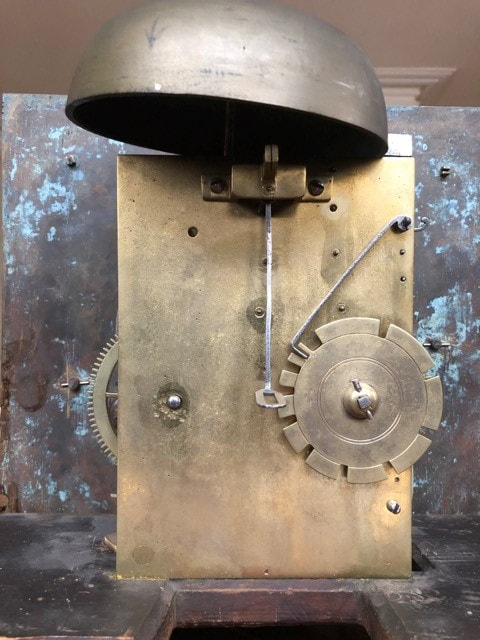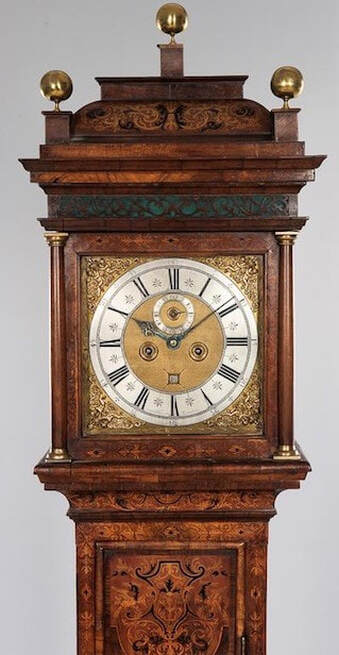|
Jon Parker writing in Antiquarian Horology for December 2019 asks the question “Was there high quality, wholesale movement manufacture in 17th century London?” He goes on to explain that there were similar features in the movements of signed clocks by some of the leading clockmakers. In 1697 the minutes of the Blacksmiths Company (B.C.) record the following statement. “The Smith who is the proper maker, was Originally so of Clock Movements and many of whose Imployment at this time are wholely therein. And that the Smith is best qualified for exercising and improving the said Art of making Clocks and is evident not only in that the greatest Artists therein of this day were Originally Smiths but from this undeniable Truth That no Clockmakers can finish a Clocke without the distinct & peculiar Workman of the Smith & yet the Smith can incisely doe of himself because the whole (indeed) is but a Branch of the Art of Smithery & therefore it is ye the said Company of Blacksmiths have hitherto enjoyed all the Clockmakers, Watchmakers & arising from ye [their] stock & having members of them.” This statement tells us that many freemen of the Company were fully employed making clock movements and the leading clockmakers had all been smiths. The earliest clock movement maker recorded was John Layton, the son of Thomas Layton, a great (tower) clockmaker, freed by patrimony on 29th Oct 1646 in the B.C. who joined the Clockmakers Company (C.C.) on 10th Mar 1653/4 (Daniels). In May 1679 John Layton was unable to pay his quarterage to the C.C. so Nathaniel Barrow, a freeman of the C.C. offered to pay his quarterage arrears and would deduct the money from the cost of the future clock movements Layton made for Barrow (Loomes). In July 1986 Sotherbys of London sold an early walnut spring table clock signed by Nathaniel Barrow with skeletonised chapter ring and barley twist columns for £39,600 despite the alterations to the movement (estimate £4-8,000). The clock movement makers were supplied with the movement parts, as well as the engines for cutting the teeth of the wheels, by brass founders working in the B.C. The early brass founders included :- John Herrington 1610-1640, Edward Burrowes 1629-1665, Geoffrey Baker 1625-1640, Chris Atkinson 1650-1690, John Mabbott 1650-1670, John Widnes 1650-1670, Edward White 1665-1712 and John Hoyland 1710-1749d. It was not until John Hoyland’s son, Richard moved to Newcastle at the end of 1744 that we are able to see the full range of the brass founders products. When the Newcastle Journal for 19 Jan 1744/5 tells us that “Richard Hoyland lately come to this town. Now at the Sign of the Six Blue Bells at the foot of Pilgrim Street. Makes and Sells all sorts of Brass work viz: Church Bells and others of any size, Engine work of all sorts, Pump Barrels, Mortars of all sizes, Moulds for Glass-houses, Clockwork, as light and clean as anywhere, Machine Candlesticks, of the newest and best Patterns, Snuffer-boxes, Plate-warmers, of the newest and best Fashions, Frames for Wax Candles, Brass fenders, Pulleys for Sashes, Brass Curtain Rods and Rings, Copper Nails, Brass Nails, Coachwork and Stove work, of all kinds and all other brass foundry work as well as and as cheap as at London or anywhere. He gives ready money, or new work for old brass.” Who were the clock movement makers producing large quantities of ready-made movements?We can often tell the difference between watchmakers and clockmakers from the number of apprentices and journeymen they employ, watchmakers usually bound fewer apprentices than the clockmakers. We know that watchmakers like William Moraley and Martin Jackson bound very few apprentices. Moraley was making watches for Thomas Tompion and Jackson was making repeating watches for Daniel Quare. We know that it would depend on their output how many apprentices the clockmakers bound, but if a clockmaker bound a large number of apprentices, he must have had a large output of clocks (or clock movements). There were some watchmakers who bound a larger number of apprentices who we will mention later.
Jon Parker in his article lists some of the leading clockmakers whose clocks have similar features to others in the group, namely Richard Colston, William Clement, Edward Burgis &Thomas Burgis, John Aylward, Thomas Herbert, John Davis of Windsor, Edward Hutchinson, Edward East, Fromanteel, Joseph Knibb, Henry Jones and Thomas Parre. Some of these makers were freemen of the B.C. e.g. William Clement 1664-1709 and Edward Burgis, son of Thomas, was working 1669-1710 and his cousin Thomas freed 1675 died about 1690. John Davis, snr., was apprenticed to John Millington of the B.C. in 1662 and went to Windsor c.1670 where he made several turret clocks, including one for the Curfew Tower of the Castle in 1689. When John Davis of Windsor took his son, John to be apprenticed in the B. C. to Thomas Parre (3) on 6 Nov 1706 he was described as a smith, not a clockmaker, because he had been trained in the Blacksmith's Company. John (jnr.) returned to Windsor in 1714 and worked there until his death in 1762. Richard Colston, freed in the C.C. 1682, was the son of John Colston who had been trained in the B.C. It is thought that some of the leading clockmakers were buying early clock movements from the Fromanteel workshop, including William Clement (see Horological Masterworks).
Henry Killmister, freed 1676-1721 was one of the few watchmakers to bind a large number of apprentices, he bound 15 apprentices in the B.C. of whom 6 were freed and 4 apprentices in the C.C. of whom 3 were freed. Henry was also a gilder which was a very lucrative but dangerous business, gilding watch movements, cases, clock dials for spring clocks as well as the brass fittings for the cases of spring clocks (see my book Early Clock and Watchmakers of the B.C.). Most of his former apprentices were also gilders, including Robert Quare, younger brother of Daniel Quare, who was apprenticed to Killmister about 1678 and freed by the B.C. on 6 Oct 1687. It is thought that Robert Quare may have worked for his brother Daniel and bound only one apprentice David Plumbe on 22 Aug.1696 but he was not freed. Robert may have died c.1700 and his son Daniel was apprenticed to his uncle Daniel in Mar 1707/8 at which time Robert was deceased. Jeremy Evans in his book about Thomas Tompion says that Tompion moved from his premises on the east side of Water Lane in 1676 to his new premises on the corner of Water Lane, west side and Fleet Street. His old premises were occupied by John Gray by 1677 who was joined by Thomas White in 1678-1692 but by 1694 William Baldwyn and John Knottesford were the tenants. All these men were clockmakers and probably supplied clocks to the Tompion workshop. John Gray was freed by the B.C. in 1674, he later moved to Durham after having married Sarah Jenkins on 1 Jan 1693/4 in London and their son Joseph was baptised there in 1696/7 (Bates- Clockmakers of Northd & Durham). Thomas White was apprenticed to Richard Chapman in the B.C. on 3 Oct 1638 and freed on 9 July 1646 and it might have been his son who later joined the C.C. in Jan 1683/4 but died c. 1693. William Baldwyn, son of Michael and grandson of William, was apprenticed to his father Michael and freed in 1685 through the B.C. John Knottesford was the son of William and apprenticed to his father in the C.C. from Mar 1680/1-1688. A number of other clockmakers in the B.C. including the Higginson’s former apprentices could have been producing wholesale clock movements.
Anthony Weston’s article in A. H. for June 2000 draws attention to bracket clocks with similar features in what he calls the “East School” of clockmakers and suggests that John Hilderson was making these clocks which have been engraved by the same hand. He did not know to whom Hilderson was apprenticed but Hilderson had worked for John Champion as a journeyman for 6 months in 1652. John Champion was apprenticed to John Harris (1) in the B.C. from 20 Dec 1632 and freed in 1640. Champion then joined the C.C. in Mar 1640/41. A number of clockmakers trained in the B. C. were producing fine longcase clocks at the end of 17th century; they included William Clement 1664-1709, Thomas Harris 1671-1700, Joseph Buckingham 1675-1720, Samuel Macham 1684-1700, Daniel Parker 1685-1700, Thomas Johnson 1676-1705 and Thomas Parre(3) 1679-1700. It is difficult mentioning one of the Parre family without mentioning some of the others. Thomas Parre(2) was apprenticed to John Warfeild in 1652 and freed by the B.C. in 1659 and he produced some very fine table clocks. There were other members of the family such as Samuel Parre freed by 1696 and William Parre who was freed in 1692 but by far the most prolific clock maker of the family must have been Henry Parre(2) who was freed in 1680, bound 21 apprentices between 1681-1719, of whom 5 were freed, including his son Edward. One apprentice, John Swaine, bound by Henry in 1712 was turned over to William Webster in the C.C. on 14 Oct 1714 and freed in 1719 by the B.C. William Webster had been apprenticed to Thomas Tompion. There are no recorded clocks signed by Henry Parre but he must have had a large output with so many apprentices. It seems certain from the above information that a large number of wholesale clock movements were being sold by clock makers of the B.C. at the end of the 17th century. If you would like to find out more about any of the clockmakers, watchmakers and gilders mentioned in this article, please do consider buying one of my books, both are available for online purchase: Clockmakers of Northumberland & Durham or Early Clock and Watchmakers of the Blacksmith's Company. If you have a specific question, please do get in touch, or leave your comment below.
0 Comments
|
AuthorKeith Bates is an amateur horologist who has been researching clocks, watches and chronometers and their makers for over 30 years. Archives
August 2023
Categories
All
|




 RSS Feed
RSS Feed